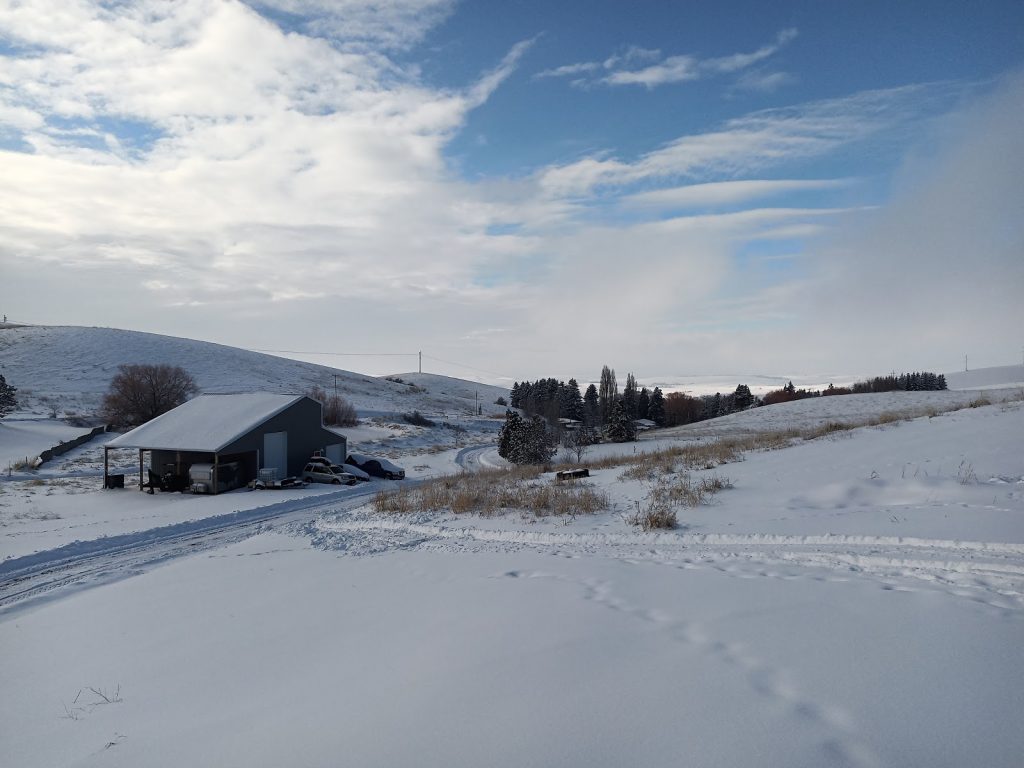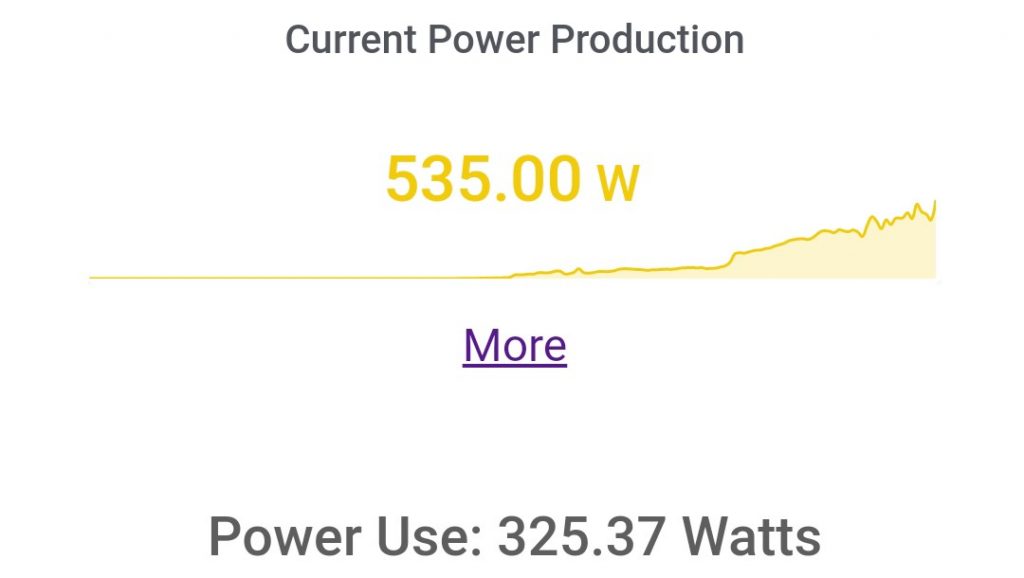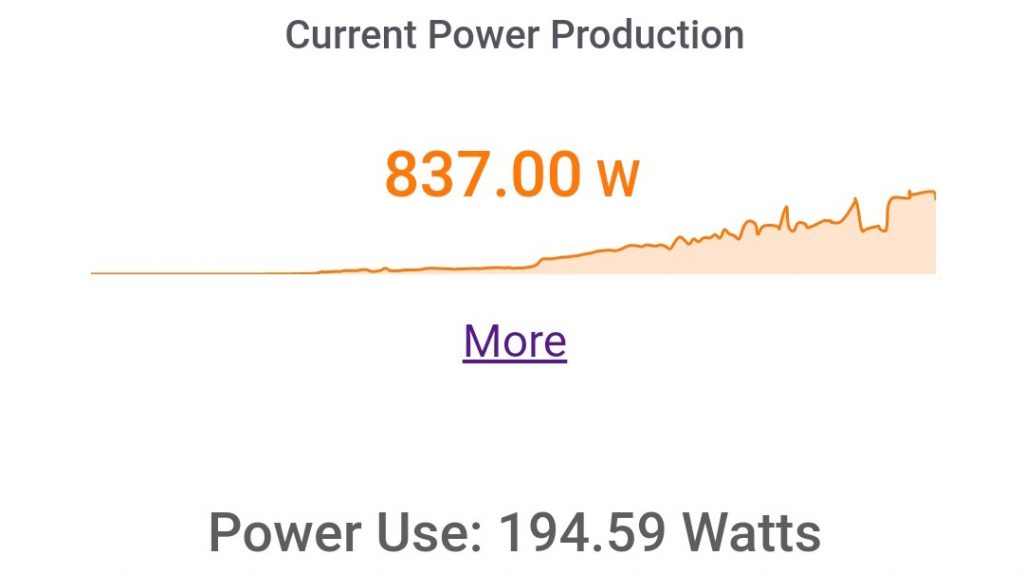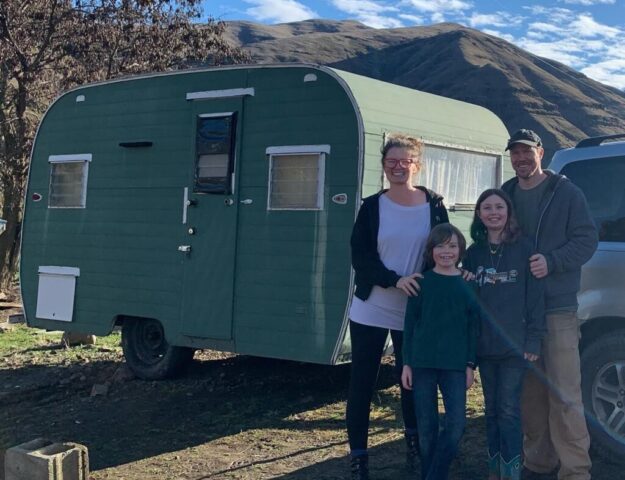Off-Grid Living in Snow Country

A good portion of the reason I choose to live tiny is for ecological reasons. Less space, less materials, less heating/cooling, less impact. Having enough while skipping what’s not needed. It’s been my long term plan to take my home off grid, eventually. I was thinking, after living in the city for two years I’d move it up to the hills to become an off-grid cabin to be used occasionally by me or my friends and family. I was sort of close, after eight years I moved it to the most epic set of hills I could find, the Palouse, and it is officially off the grid. It’s not an occasional use situation though, we are still here, living in it full time. We’re wrapping up year nine in just a couple months.
It has been a long journey to get off the grid but it’s not really something that happens overnight. It’s important though, we have an energy crisis right now. Every 13 years the world’s population grows by about 1 billion people. Additionally, technology advances at rates much faster than that. There is a tremendous and growing need for energy to power all of the things for all of the people. Our future isn’t about which energy we will choose going forward, our future is about being able to have enough to do the things we need to.
There is no such thing as clean energy.
Historically we use coal, oil and hydro power. We are all well versed in the drawbacks of nuclear, coal, and oil. Hydro may cause less pollution but can be detrimental to many species in our food web. The drawbacks of solar and wind, often called ‘clean energy’, can also be very damaging. The mining for precious metals to manufacture the components in each system has had disastrous effects and can easily poison ground water. Particularly because the extraction of these materials typically happens in places where safety regulations either don’t exist or aren’t enforced. Additionally, batteries, a complimentary system to ‘clean energy’ sources, also have huge energy footprints through manufacturing.
So, while clean energies aren’t a silver bullet, they are still in their infancy stage and there is a lot of potential and room for improvement on the drawbacks. We are only just starting to scale their production and making more efficient panels, batteries and everything in between. The drawbacks are in the raw material stage but the components can be recycled and reconditioned almost entirely. Indefinitely. Every industry starts kind of clunky. There is a long way to go with solar and wind but the untapped potential is huge. We have explored oil and coal to their limits and there is a finite amount of them available. The opposite is true with solar and wind.
Every single type of power has a drawback, there is no such thing as clean energy. There are financial interests on each side of the political aisles for various types of power but the only way to truly help the environment is lessening the amount of power you use on a day to day basis.
Scale Matters
Power is sort of like food. It’s always a good idea to have your own garden or storage supply in case there is a failure in the market, you won’t go hungry. Also said as, redundancy matters. We are really pushing the bounds of our energy infrastructure. This is why power companies offer money or other incentives to add solar to your roof. It expands their system and decreases transportation costs. Energy loses value, literally, the further it has to travel from where it is harvested. 100 small farms (energy systems) are more secure than 1 giant farm (energy system). It would take 100 failures to wipe out the small systems completely while just one could take out power on a giant system. Note that I didn’t say they are more economical. The value of scale is financial. But, security of the system is not a given at any scale. It’s good to have a back up plan, even if it is just a generator.
How do you decide how much you need?
The most important part for a successful small scale power production system is knowing your power needs. It’s always a good idea to minimize them if you can, too! Actually going through your day to day life, writing down what you use that takes power, how much power it takes, and how long you use it for. Over time you will have a clear idea of how many watts you use and what size of system you need. There is not one size of solar array for a certain number of occupants or house size. How much power you need responds directly to how you use power. In general, if it produces heat it doesn’t not use electricity efficiently. If you can power that item a different way it’s probably a good idea.
For an example, our ‘normal rate’ of power use in our tiny house is around 200-300 watts per hour during our waking moments. About 100 watts per hour while asleep. If I had an electric stove, that alone would use about 3,000 watts per hour of use. For this reason we choose a gas range and have wood burning as our back up. Our heat is also gas with a wood backup, though we do have a low draw electric heater we use at times as well, even in winter we can power this regularly.
Like budgeting, not spending money is just as important as earning the income. Not wasting power is just as important as generating enough. Turning lights off when you’re not in a room counts. When it comes to heating a house, making sure the building science that built that house is sound is important, too. A leaky house will be inefficient to heat via any power source. We are currently sitting in the teens outdoors and do not heat nonstop, the house holds its heat in pretty effectively.
There is a lot of misinformation out there
It does not have to cost an arm and a leg. When we moved to our new location we got together with the power company who wanted $16,000 to bring power to our property, and that was if we did all the labor of digging trenches. We decided right there we’d just stay off the grid. We spent a total of $2,800 on refurbished solar panels (2,500 watt array), 6 AGM batteries (600 Ahr) and all the components in between to power our tiny house (we have since bought 6 more batteries). Our panels were used for 20 years before we got them and then they were refurbished to last another 20+. We were able to avoid spending a lot (they cost $68 for each 250W panel) as well as avoiding the use of fresh raw materials. The components in solar and wind power are recyclable and refurbishable, a huge benefit. You can get a lot of use out of the same raw materials.
I cannot get over the recent posts from some media personalities disparaging wind and solar power as valid options because of the winter storms from the latest polar vortex. We’ve had warnings of this polar vortex and the potential outages since the middle of January (I track these things on my news feed because they can affect how we use our power). The breakdowns in the wind generation could have been avoided but, as I understand, they relied on a system designed to supplement other power sources for a much bigger percentage of power, which it wasn’t designed to do. It is not a failure of the system but a failure of the power strategy.
In addition, I have seen people sharing that solar does not work in the cold. That is false. We get a fair amount of snow here. You do have to keep the panels clear of snow to generate substantial power but let me show you what most would consider one of our worst solar days this winter.
A case study of solar power generation on a crummy day:
We are completely off the grid in our tiny house. We use a combination of solar (primary) and wind for power. We have a generator to back up the system because we’ve sized our batteries to last 2 days but we get storms that last longer than that. Without a bigger battery bank we need to supplement at times. We are far enough north that the winter offers us an average of 4.7 solar hours per day, that is, time where we can harvest the sun’s energy. Last week or so we had three solid days of snow. We do generate power in the snow storm, in fact, more than you think because the white reflects so well. The problem with snow is the accumulation. We’ve placed our solar panels on the ground so that we can clean them in these situations.
We ended up getting a total of 13 inches in 3 days. Now, that’s not a lot, but it is enough to give an example of how solar performs in those conditions. I’ll be honest, I wasn’t great at cleaning the panels because it was easier to push the button to start the generator from the cozy couch. Once a day I clean the panels if it’s snowing. When I read a post a news personality made about how solar doesn’t work in the cold I had to run my own case study just to disprove it. Now I offer that to you.
- It’s 9:00 am
Normally I have a very clear view of my barn but this is a very foggy morning. The household woke up about two hours ago. The sun hasn’t even peeked into our little valley yet. The TV’s on, fans (ceiling, kids room, composting toilet) are running, our battery is pretty depleted. For the health of our batteries we typically start the generator if we get down to half power (24 V) which does happen in winter, usually during long storms. Most days we can make it just fine because we’ve oversized our array for our needs. This is what it “looks like” outdoors right now. No sun in view, pretty foggy and snowing.
I put on my snow boots over my jammies and head out, this is what our 2,500 watts of solar array look like. I had cleaned them off the day before and it was a windy enough night that only a little snow stuck to the panels. I would not normally clean them off at this stage because the sun will peak up and warm the panel and melt it off pretty quickly.
At this semi-covered state they were only generating 79 watts of power. That is less than the 253 watts of power we were using. You have to remember though the sun just barely peaked up so it was not an ideal angle for power production either. For the sake of this experiment, I cleaned them.
After being brushed off they bumped up immediately to 231 watts (and our fridge stopped cycling so our power use dropped a little to 180 watts).
This is a worst case scenario kind of day and we are still generating enough to keep all of our power stuff going before the sun really even peeks up very high. On a day like today we use our propane heater. Our electric heater/air conditioner is high efficiency and uses a max of 640 watts, which is usually achievable, but in winter it’s touch and go so we have backups.
- 10:00 am
An hour later, it’s still a crummy looking day outside, the sun is a little higher in the sky but we’re not at a peak by any means. Still no trace of sunshine with my naked eye, just a foggy, snowy day but our power has doubled to 535W.

Our power input is up, so is our power use because James went to work. The office is up and running a couple computers and a circulation fan. We still out generating our power use on a cruddy morning. The extra power is banked in our batteries to get us through the night.
- 11:30am
This is approximately an hour and a half later, just before lunch. We’re getting closer to peak solar angle. The fog has mostly lifted but it’s still snowing enough that we can’t see far off in the distance. Definitely no sunshine visible still.

Nonetheless, we’re generating about four times as much power as we’re using. By this point our batteries are usually topped off and we have about four more hours of sunshine on this particular day. We oversized our array because we got such a good deal on our panels and our winter solar hours are fairly low at our latitude. They don’t take long to top off our batteries, even on a crumby day. If we wanted to increase our battery bank size we could get by much easier without a backup generator but we feel like we’re at a pretty decent balance.
I mentioned we use wind, too. Our wind turbine is much smaller and we haven’t been able to make it work well for us despite having pretty significant winds in our little valley. In our experience, solar is far more efficient per dollar if you can get refurbished parts. Our thinking was that the winds usually happen at night when there is no sun so it could supplement the power on overcast or stormy days. Our particular model hasn’t worked well for us and we can’t figure out why but we fortunately haven’t had problems with solar at all. It’s really fairly basic after you get past that big learning curve at the beginning!
For self-sufficient living we’ve learned, redundancy of systems is key. We look at the power grid as one of our backups. If our systems all failed we’ll go book a hotel for a night or two and enjoy a warm bath! Then we’ll get back out there and fix it however we need to. Even if you live on the grid I would suggest you have a redundant source for heating and cooking in your home should the power go out. Without significant changes I think we will be seeing more large scale failures in the future. It never hurts knowing what you use so you can be better prepared to conserve energy as needed!



